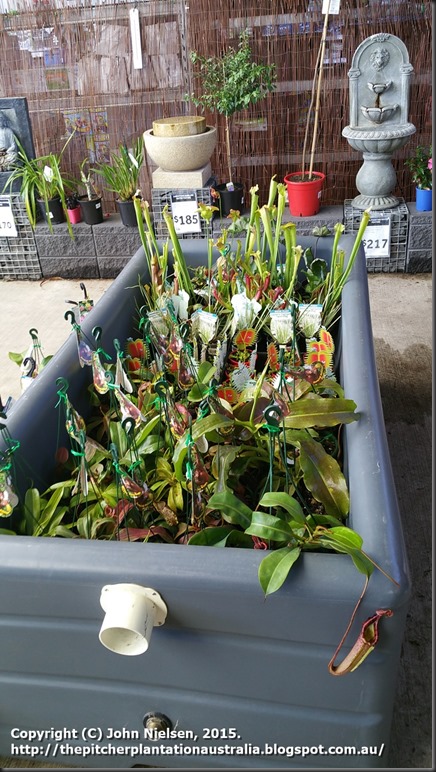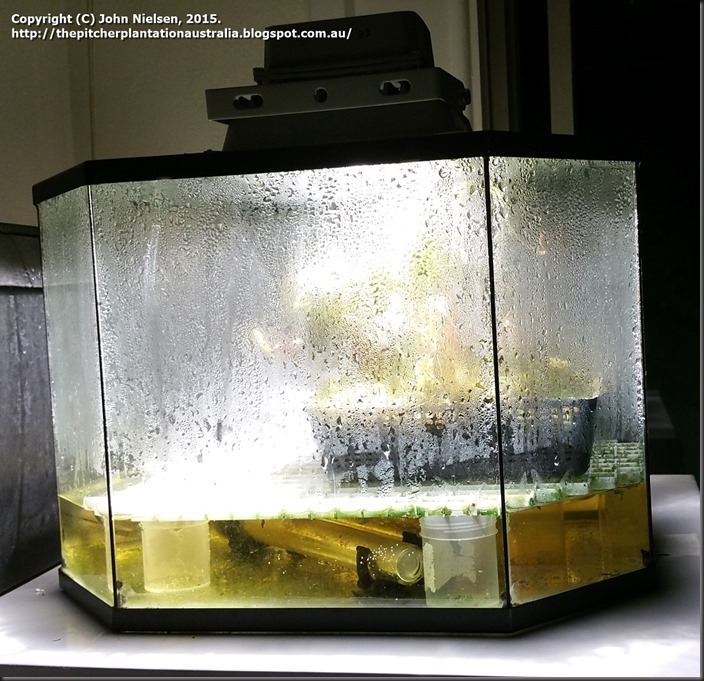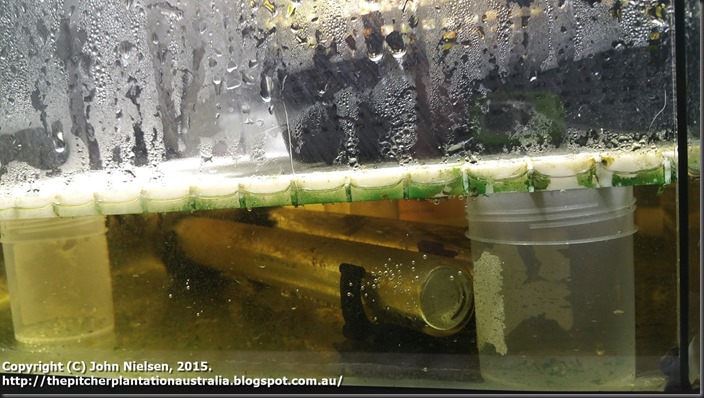Way back in 2008, before I started this blog and before I even had much of a Sarracenia collection, I set up a terrarium on my desk at work for Nepenthes and Drosera adelae. I had just tried – and failed – at working as a non-entomologist, and the terrarium brought me a lot of joy at a time when I was really down. I started it off with some Nepenthes ampullaria f. green from Captive Exotics (it was being run by Tony Camilleri then!) and two clones of Drosera adelae from Greg Bourke, followed by some ex-TC Nepenthes from the Sydney ICPS later that year.
Above is a picture of how it looked by late 2008 – the Sphagnum was growing and the plants were going from tiny ex-TC things to being recognisable for their individual species. I eventually gave away the other plants (or lost them) and kept just the two N. ampullaria. The Drosera adelae eventually spread through the tank, but I presume only the green form did well – they even burned and retreated to their roots when I upped the wattage of the lights and never turned the nice red colour some growers achieve! I also grew Pinguicula in the tank for a while with no problems – in fact, the terrarium was perfect for getting leaf cuttings to grow with a high strike rate.
The terrarium gave me much joy and taught me a lot about cultivation.
I learned about just how dark offices are and how bright the terrarium light needed to be. I found 2 x 24W compact fluoro lamps (1 warm white and 1 cool white) worked well.
I learned how using an aquarium heater and a water bath provided both heat and humidity, and how to vent the tank to allow for air circulation.
I learned how Drosera adelae did not like growing at a constant 28C and appreciated the heater being hooked up to the timer with the lights to get a night-time temperature drop.
I found through trial and error that the heater was not even needed – the office was heated to 21C on weekends and the CFL lamps provided enough heat on their own.
I learned that fish food would mould up on the D. adelae.
I learned how potted tanks worked better than a planted tank.
I even learned that a still unknown colleague would wait until I added Drosera prolifera to the setup before taking a holiday to turn the mains off at the wall for three weeks…
Just when I had everything down pat and the terrarium looked great, I was asked by a certain science museum to loan them my terrarium for a botany exhibition in 2011. They insisted that I added a Sarracenia and a Venus’ flytrap to the terrarium, and would not take no for an answer. So, instead of telling them it was my terrarium and they could take it or leave it, I caved and added a S. purpurea and a VFT that, unknown to me, carried mealybugs as hitchhikers.
Big mistake. The result – a mealybug infested terrarium that never recovered and had to be killed off because the infestation was so chronic. It was devastating – the terrarium and its inhabitants had become friends from nearly daily interaction with them. I had watched them grow and learned how to meet their needs. It was so devastating I did not even want to set it back up again. The terrarium went into the shed, where it stayed for the next four years.
Fast forward to Monday this week. I was at the Canberra Masters store (= Lowes if you are from North America) getting some gear for a project at home when I came across this…
Nice – some carnivores just in from Triffid Park. Taking a closer look, I saw that there were a bunch of Nepenthes x hookeriana in the consignment. Perfect timing! After my trip trying to find Drosera schizandra, I had decided it was high time to get the terrarium going again, and I had even gone so far as to get the tank out and test the heaters. And now, without any prompting, here were several plants of an ideal terrarium Nepenthes going begging (well, not quite) for a new home. A few minutes later, I was on my way home with a fine N. x hookeriana, ready to re-establish the terrarium.
So, here ‘tis – terrarium V 2.0. I admit that the tank is not hugely photogenic – the condensation will always obscure the plants with this type of setup. But it works.
The plant is a N. x hookeriana, Triffid Park clone (sorry for the bad photo). It already has a basal rosette starting to form. Yes it is a bit on the big size, so once the basal is established, its cutting time! The substrate is Sphagnum cristatum stolen from my Sarracenia bogs. The planter is a 20 cm square waterlilly basket that has been trimmed down to size. The holes in these baskets will allow the Sphagnum to grow through. Nepenthes ampullaria (and hybrids) appreciate a low pot, as it allows them to spread out more (and hopefully produce basal pitchers!).
My setup uses a water reservoir with two aquarium heaters for climate control. The temperature regime is 28C for 16 hours and 22C for 8 hours. This provides a nice day-night temperature drop that Nepenthes and rainforest Drosera appreciate. To achieve this, one heater is set to 28C and turns on and off with the light. The second heater is set to 22C and is powered constantly. This way, as soon as the light turns off, the tank will cool until it reaches 22C, when the second heater will kick in. This is not needed if you use a centrally heated office building (21C is nominal heating here), but it is certainly needed for our frosty winters when our house can drop right down to 5C on a morning that is –8C outdoors. This is lethal for Drosera adelae and would make lowland Nepenthes very sick very fast.
The light is a 20W COB LED floodlight, photoperiod set up 16 hours light: 8 hours dark by an electric timer. The idea for using this type of light came from a grower on the CPUK forum who grows beautiful Nepenthes ampullaria in terraria using a similar LED. The light I use has its ballast on top, so any heat produced is radiated away from the tank. I have to agree with this grower that a very bright light will keep some Nepenthes like ampullaria and its hybrids compact – the amps I grew previously produced basal pitchers and never outgrew the tank in the two years they lived there. When I had tried brighter lights the amps leaves had burned and it stopped growing until I changed the wattage back down. But I suspect I will still have to keep the hookeriana under control with regular pruning due to the rafflesiana parentage… at least it means plenty of cuttings to share with others!
Some more mods are still in the works – I need a metallic car sunshade to wrap around the back of the tank and for the cover for insulation (plus the front bottom to hide the infrastructure!), and to keep as much light as possible in the tank. I will also add a well washed coir hanging pot liner over the platform for aesthetics (it helps stop algae from growing in the tank) and because it acts like capillary matting that helps with watering. A second pot is planned for this setup – hopefully for a red for N. ampullaria. I also hope to get some Drosera adelae and D. prolifera later this year to finish the tank off. I will update and share pics as these mods happen and new plants are added.
Cost for a setup like this? You can spend as little or as much as you like. Ask around and you may well get a fish tank and an aquarium heater off a friend or colleague for free, or at least for a fraction of a new tank (but beware leaking tanks!). The platform is acrylic light diffuser – try an acrylic shop to get it cheap or see if you can scrounge an offcut for free. The supports for the tank are some old specimen vials that had been used for insect collecting, but some cheap plastic containers from a dollar store would work just as well. The waterlilly basket was an old one that had a wall broken by a Darlingtonia stolon punching through it. The coir liner will be $4.50 and the car sunshield (and double-sided tape to hold it on) will be from a dollar store for pocket change. The most expensive parts of my setup were the light and the Nepenthes, which were $30 each. If you are lucky enough to have a CP society at easy access (which I don’t – I haven’t been to an AUSCPS meeting in a long time), you may be able to beg/swap a suitable terrarium plant for very little.
Do you need a terrarium to grow CPs? It depends on your climate and your situation. For me, a terrarium is the only viable way I can grow lowland Nepenthes. So I grow them using this method. The catch with a terrarium is understanding – and learning – that your plants will be even more dependent on your getting it right. For example, when I first tried to grow my 2009 terrarium, I thought the office lights would be more than enough. I soon learned I was wrong and then spent the next few months trialling different wattages of CFL lights until I got it right. I may well find the LED I am using is not right and will need to go back to CFLs again – who knows? Patience, keeping an open mind and accepting that trial and error will always be part of the journey are key to getting a well grown terrarium.
Next up – the first Sarracenia pitchers have opened for the 2015 season, and it looks set to be a fantastic year for Sarracenia flava! Check back soon for a photo update.




